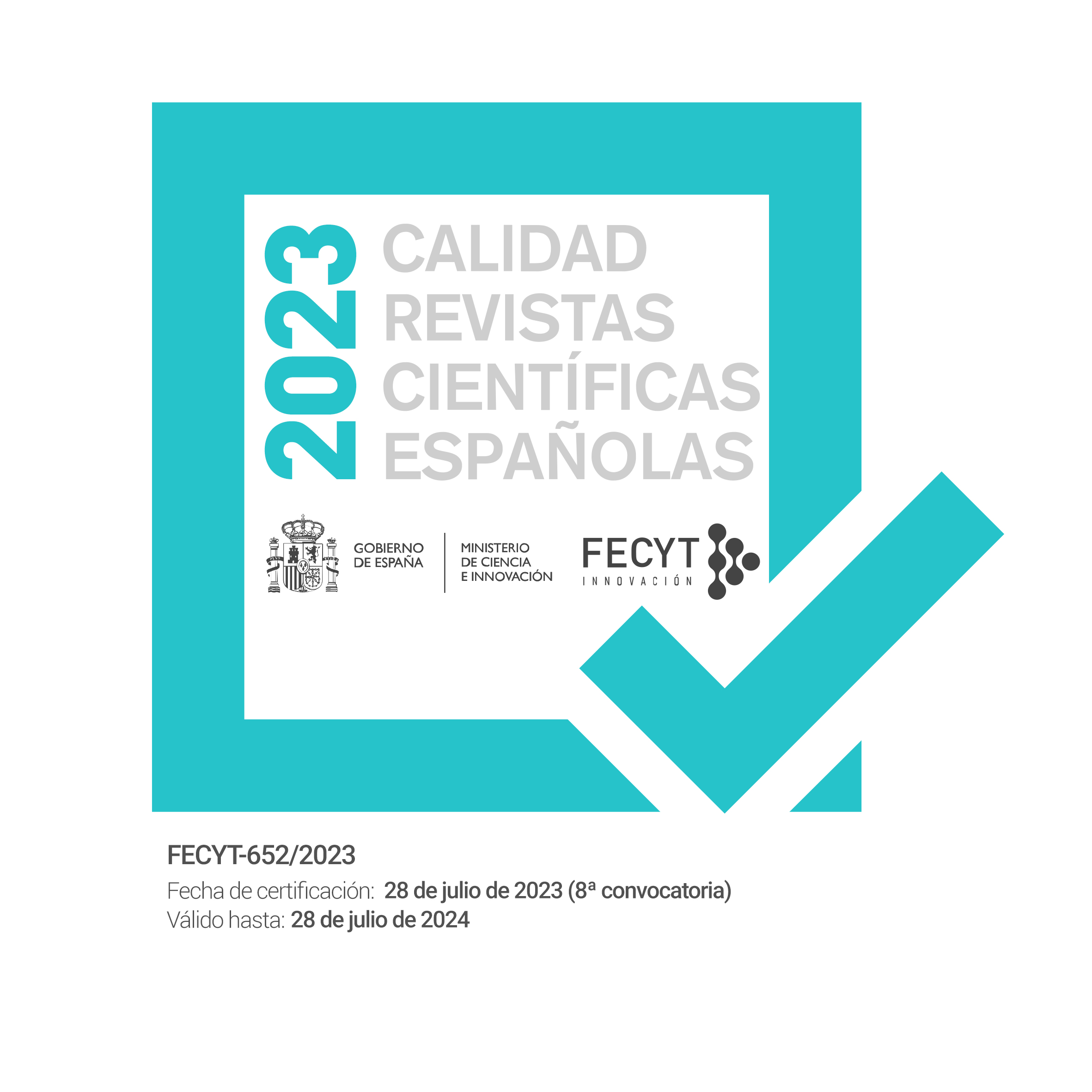Trump tuiteó su malestar: English Argument Structure Borrowing in Spanish
Resumen
Abstract
This paper investigates argument structure borrowing as regards the verb tuitear from the model of the English verb tweet. In order to test this borrowing hypothesis, two research questions are posed: 1) To what extent does the Spanish verb mirror the argument structure of the English verb?; and 2) Is the argument structure of tuitear dissimilar to other semantically related Spanish verbs? This study is based on empirical evidence from Davies’s News on the Web (NOW) English and Spanish corpora. The analysis of two samples of 1,000 constructions of tweet and tuitear reveals a striking similarity in structural behavior. The contrast with other Spanish instrument-of-communication verbs (e.g. telefonear, telegrafiar, faxear, radiar, televisar, cartear and cablegrafiar) shows that the behavior of tuitear is unique in this class.
Keywords: tweet, tuitear, borrowing, argument structure, instrument of communication verbs.
Resumen
Este artículo investiga el préstamo de la estructura argumental del verbo tuitear a partir del modelo del verbo inglés tweet. Para probar la hipótesis de préstamo se plantean dos preguntas de investigación: 1) ¿Hasta qué punto copia el verbo español la estructura argumental del verbo inglés? y 2) ¿Es la estructura argumental de tuitear diferente a la de otros verbos españoles relacionados semánticamente? El estudio se apoya en material empírico de los corpus News on the Web (NOW) en inglés y en español. El análisis de dos muestras de 1000 construcciones de tweet y tuitear muestra una sorprendente semejanza en su comportamiento estructural. El contraste con otros verbos de instrumento de comunicación españoles (telefonear, telegrafiar, faxear, radiar, televisar, cartear y cablegrafiar) revela que el comportamiento de tuitear es excepcional entre los miembros de esta clase.
Palabras clave: tweet, tuitear, préstamo, estructura argumental, verbos de instrumento de comunicación.
Citas
Baker, C. & Ruppenhofer, J. (2002). FrameNet’s frames vs. Levin’s verb classes. Proceedings of the 28th Annual Meeting of the Berkeley Linguistics Society (pp. 27–38). Berkeley, Calif.: Berkeley Linguistics Society.
Bar∂al, J. (2003). Case and argument structure of novel verbs of communication in Icelandic. In L. O. Delsing, C. Falk, J. Gunlög & H. A. Sigursson (Eds.), Grammar in Focus. Festschrift for Christer Platzack II (pp. 25–35). Lund: Department of Scandinavian Languages.
Beavers, J., Levin, B. & Tham, S.W. (2010). The typology of motion expressions revisited. Journal of Linguistics, 46, 331–377. doi: 10.1017/S0022226709990272
Bouso, T. (2017). Muttering contempt and smiling appreciation: Disentangling the history of the Reaction Object Construction in English. English Studies, 98(2), 194–215. doi: 10.1080/0013838X.2016.1210358
Bouso, T. (2020). The growth of the transitivising reaction object construction. Constructions and Frames, 12(2), 239–271. doi: 10.1075/cf.00041.bou
Caballero, R. & Paradis, C. (2018). Verbs in speech framing expressions: Comparing English and Spanish. Journal of Linguistics, 54, 45–84. doi: 10.1017/S0022226717000068
Cano Aguilar, R. (1987). Estructuras Sintácticas Transitivas en el Español Actual. Madrid: Gredos.
Croft, W., Bar, J., Hollmann, W. Sotirova, V. & Taoka, C. (2010). Revising Talmy’s typological classification of complex event constructions. In H. Boas (Ed.) Contrastive Studies in Construction Grammar (pp. 201–236). Amsterdam: Benjamins.
Crystal, D. (2001). Language and the Internet. Cambridge: Cambridge University Press.
De Clerck, B., Verroens, F., Willems, D. & Colleman, T. (2011). The syntactic flexibility of (new) verbs of instrument of communication. A corpus-based study. Functions of Language, 18(1), 57–86.
De Mooij, M. (2014). Human and Mediated Communication around the World. A Comprehensive Review and Analysis. Heidelberg: Springer.
Dirven, R., Goossens, L., Putseys, Y. & Vorlat, E. (1982). The Scene of Linguistic Action and its Perspectivization by Speak, Talk, Say and Tell. Amsterdam: Benjamins.
Downing, A. (2015). English Grammar: A University Course. 3rd edition. London and New York: Routledge.
Edwards, J. (2012). Multilingualism: Understanding Linguistic Diversity. London: Continuum.
Faber, P. & Sánchez, J. (1990). Semántica de prototipos: el campo semántico de los verbos que expresan la manera de hablar frente al de los verbos de sonido en inglés y español. Revista Española de Lingüística Aplicada, 6, 19–29.
Goldberg, A. E. (1995). Constructions. A Construction Grammar Approach to Argument Structure. Chicago: The University of Chicago Press.
Görlach, M. (Ed.) (2001). A Dictionary of European Anglicisms: A Usage Dictionary of Anglicisms in Sixteen Different Languages. Oxford: Oxford University Press.
Gutiérrez Ordóñez, S. (1999). Los dativos. In I. Bosque & Demonte, V. (Eds.), Gramática Descriptiva de la Lengua Española (pp. 1855–1930). Madrid: Espasa Calpe.
Heine, B. & Kuteva, T. (2005). Language Contact and Grammatical Change. Cambridge: Cambridge University Press.
Jackendoff, R. (1990). Semantic Structure. Cambridge, Mass.: MIT Press.
King, R. (2000). The Lexical Basis of Grammatical Borrowing: A Prince Edward Island French Case Study. Amsterdam: John Benjamins.
Kranich, S., Becher V., Höder S. & House J. (Eds.) (2011). Multilingual Discourse Production: Diachronic and Synchronic Perspectives. Amsterdam: Benjamins.
Kwak, H., Changhyun, L., Hosung, P. & Moon, S. (2010). What is Twitter, a social network or a news media? Proceedings of the 19th International Conference on World Wide Web (pp. 591–600). New York: Association for Computing Machinery. doi: 10.1145/1772690.1772751
Levin, B. (1993). English Verb Classes and Alternations. Chicago: The University of Chicago Press.
Levin, B. & Rapoport, T. R. (1988). Lexical subordination. In Proceedings of the 24th Annual Meeting of the Chicago Linguistic Society (pp. 275–289). Chicago: Chicago Linguistic Society.
Maldonado González, C. (1999). Discurso directo y discurso indirecto. In I. Bosque & V. Demonte (Eds.), Gramática Descriptiva de la Lengua Española (pp. 3549–3595). Madrid: Espasa Calpe.
Martínez Vázquez, M. (2005). Communicative constructions in English and Spanish. In C. S. Butler, M.A. Gómez González & S.M. Doval Suárez (Eds.), The Dynamics of Language Use: Functional and Contrastive Perspectives (pp. 79–109). Amsterdam: Benjamins.
Martínez Vázquez, M. (2014). Reaction object constructions in English and Spanish. Spanish Journal of English Studies, 35, 193–217.
Martínez Vázquez, M. (2015). Satellite-framed patterns in Romance languages: A corpus-based study. Languages in Contrast, 15(2), 182–208.
Martínez Vázquez, M. (In press, 2021). Constructional borrowing through computer mediated communication verbs. In R. Enghels, D. Castilleja & A. Vande Casteele (Eds.), Cruzando fronteras: español e inglés en contacto. Prácticas lingüísticas, ideologías e identidades. Roma: Aracne.
Mateu, J. (2012). Conflation and incorporation processes in resultative constructions. In V. Demonte & L. McNally (Eds.), Telicity, Change, and State: A Cross-Categorial View of Event Structure (pp. 252–278). Oxford: Oxford University Press.
Patzelt, C. (2011). The impact of English on Spanish-language media in the USA. A qualitative analysis of newspaper articles. In S. Kranich, V. Becher, S. Höder & J. House (Eds.), Multilingual Discourse Production: Diachronic and Synchronic Perspectives (pp. 257-279.) Amsterdam: Benjamins.
Peterson, E. & Fägersten, K.B. (2018). Introduction to the special issue: Linguistic and pragmatic outcomes of contact with English. Journal of Pragmatics, 133, 105–108. doi: 10.1016/j.pragma.2018.06.005
Pountain, C. J. (1994). Syntactic anglicisms in Spanish: innovation or exploitation? In M. M. Parry, W. V. Davies & R.A.M. Davies (Eds.), The Changing Voices of Europe (pp. 109–24). Cardiff: University of Wales Press.
Pulcini, V., Furiassi, C. & Rodríguez González, F. (2012). The lexical influence of English on European languages: From words to phraseology. In C. Furiassi, V. Pulcini & F. Rodríguez-González (Eds.), The Anglicization of European Lexis (pp. 1–24). Amsterdam: John Benjamins.
Quirk, R., Greenbaum, S., Leech, G. & Svartvik, J. (1985). A Comprehensive Grammar of the English Language. London: Longman.
Schmidt, S. & Diemer, S. (2015). Comments on anglicisms in Spanish and their reception. SWPL, 5(8), 8–18. doi: 10.22028/D291-23645
Suñer, M. (2000). The syntax of direct quotes with special reference to Spanish and English. Natural Language and Linguistic Theory, 18, 527–578.
Talmy, L. (1985). Lexicalization patterns: semantic structure in lexical forms. In T. Shopen (Ed.), Language Typology and Syntactic Description 3: Grammatical Categories and the Lexicon (pp. 57–150). Cambridge: Cambridge University Press.
Talmy, L. (2000). Toward a Cognitive Semantics. Typology and Process in Concept Structuring. Cambridge, Mass.: MIT Press.
Trips, C. & Stein, A. (2019). Contact-induced changes in the argument structure of middle English verbs on the model of old French. Journal of Language Contact, 12(1), 232–267. doi: 10.1163/19552629-01201008
Vázquez, G., Fernández, A. & Martí, M.A. (2000). Clasificación Verbal. Alternancia de Diátesis. Quaderns de Sintagma 3. Lleida: Edicions de la Universitat de Lleida.
Verroens, F., De Clerck, B. & Willems, D. (2010). I blackberried him twice and skyped him a happy Father’s day. Linguisticae Investigationes: Revue Internationale de Linguistique Française et de Linguistique Générale, 33(2), 285-306.
Vorlat, E. (1982). Framing the scene of linguistic action by means of speak. In R. Dirven, L. Goossens, Y., Putseys & E. Vorlat (Eds.), The Scene of Linguistic Action and its Perspectivization by Speak, Talk, Say and Tell (pp. 9–35). Amsterdam: Benjamins.
Descargas
Publicado
Número
Sección
Licencia
Reconocimiento – No comercial (CC BY-NC). Bajo esta licencia el usuario puede copiar, distribuir y exhibir públicamente la obra y puede crear obras derivadas siempre y cuando estas nuevas creaciones reconozcan la autoría de la obra original y no sean utilizadas de manera comercial.
Los autores retienen todos sus derechos de publicación y copyright sin restricciones.









